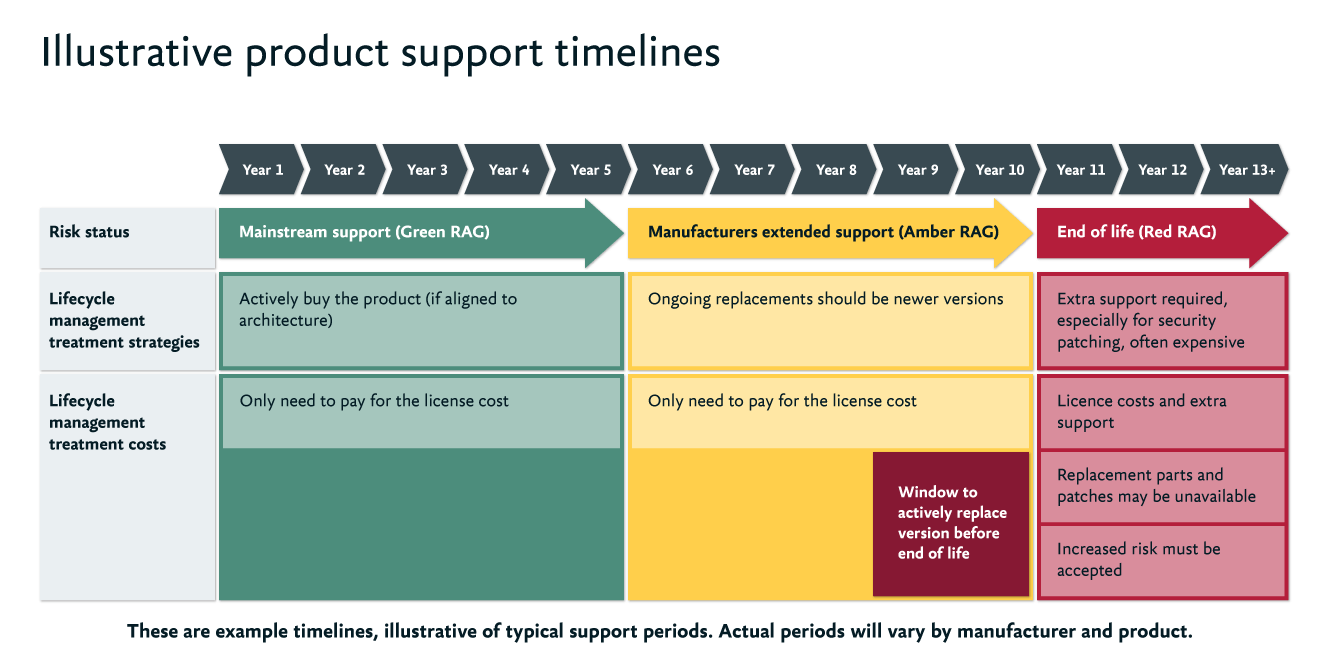You’ve developed your blueprint for technology systems modernization. But how can you map what your operational needs are likely to look like in 5-10 years’ time as you strive to control obsolescence risks and make the most of tech advances? This is where a ‘Modernization Hub’ to oversee your legacy estate and coordinate modernization could prove so valuable. How would this oversight of your legacy estate work? How can you build it into a ‘new normal’ portfolio management approach to systems operation and optimization?
If systems begin to fail and ‘mission critical’ operations break down, the immediate response would be, “if only we’d planned ahead”.
Legacy technology estate planning
A tech lifecycle Modernization Hub would offer just this kind of early warning and planning for your legacy tech estate. By tracking where each application and systems is on its usable lifecycle, you’ll be able to map when the initial support period will run out and the options for replacement or extended support to keep critical IT running. As extended support runs out, functionality deteriorates and security updates are withdrawn, the need to update and replace critical systems becomes even more pressing.

Time to target and plan for technology transformation
This lifecycle tracking approach allows you to develop a proactive roadmap for maintaining and modernizing critical components of your tech estate. The data it generates would also help you to weigh-up the cost-benefits of outsourced options such as Software-as-a-Service (SaaS) models, which could not only reduce obsolescence risk, but also support access to the latest capabilities.
Ultimately, this modernization command-and-control capability allows you to manage technology as a balanced portfolio, pinpointing risks and opportunities, providing enough time and scope to maximize your options and targeting investment where it can make the most difference. It also gives your team the opportunity to identify and avoid resource draining peaks in implementation activity, or in the worst-case scenario, a hurried scramble to get operations back up and running when critical components within your tech estate fail.
Three ways to optimise your technology lifecycle command-and-control capability
What then are the key foundations for this tech lifecycle command-and-control capability and how can you build it into a new normal approach to tech portfolio optimization? Three priorities stand out:
1. Build the technology lifecycle into business planning
The Modernization Hub is not just there to keep systems running and mitigate obsolescence risks, but also deliver your strategic objectives.
Your modernization command-and-control unit should therefore engage closely with business users (e.g. Operations, Engineering & Tech Service organizations) and respond to their systems demands. It’s also important to test potential initiatives against strategic imperatives, ensuring that there is appropriate ‘pull’ from operational leadership and the end-users. The results will help align tech initiatives with overall business strategy, strengthen investment cases and ensure user buy-in for the outcomes. You can support this by establishing dashboards to track and demonstrate progress in both risk reduction and business benefits.
The big danger is waiting for obsolescence issues to become so pressing that you end up rushing through business planning stages or bypassing them altogether. Cutting business teams out of the loop risks losing user support, and may also mean that you fail to explore options that are more closely aligned with the business’ needs.
2. Mobilize and deliver technology modernization
Setting up a dedicated Modernization Hub will help you to strengthen oversight and assurance as initiatives shift from concept, through delivery and into implementation.
One of the team’s key functions is identifying the most appropriate delivery vehicle for any initiative by looking at both its goals and dependencies. It’s important to look at how the team will interact with any existing delivery management and control functions in your business, and whether there will need to be any changes to roles and responsibilities to help establish clear interfaces between them. Further priorities include engaging with end-users throughout delivery and implementation, ensuring that they have a full role in shaping, implementing and testing the initiative’s requirements.
Inevitably, there may be some resistance to change even when the benefits are clear. So it’s important to ensure sufficient board-level sponsorship. It’s also essential that project and change management teams are empowered to implement critical modernization (with appropriate checks and balances), rather than giving business teams a blanket veto.
3. Build in clear governance and oversight
For greatest impact, planning and monitoring should be structured into short-term (in line with an annual business plan), medium-term (2-5 years) and long-term (5 year-plus) horizons. This will ensure that initiatives are targeted and tracked from inception through to delivery, while helping to build tech lifecycle management into the DNA of decision-making and performance management within your organization.
In multi-year projects, the big risks are a loss of focus and accountability or delivery of outcomes that no longer meet the needs of the business. The results of this can not only impede project oversight and momentum, but also divert resources to maintaining the obsolete technology earmarked for replacement and modernization. It’s therefore important to build in a clear interface between strategic planning and delivery teams. Further priorities include a clear and consistent approach for transferring accountability for delivery across the project lifecycle, especially when software development moves on from build to testing and implementation phases.
In control
With the tech lifecycle Modernization Hub capability in place, you can maintain effective oversight and management of your tech estate, knowing what’s coming and the impact on your operations. You’ll also be able to balance the demands of maintenance and modernization in an assured and proactive way.
Let’s talk
We’re working with businesses across all sectors to help them sustain operations and cut through the complexities of legacy tech transformation. Contact us if you’d like to know more.










